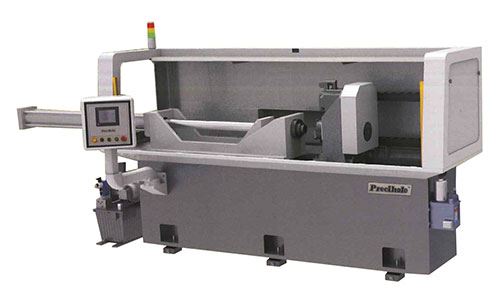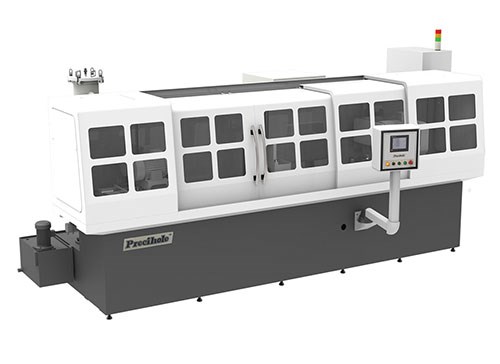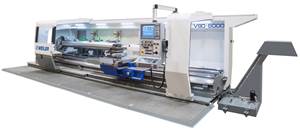Gun Barrel Manufacturing Cell Combines Holemaking Operations
Precihole Machine Tools has introduced a dedicated manufacturing cell consisting of holemaking equipment to perform all necessary operations on the ID to convert a bar of metal to an assembly-ready gun barrel.
In the last several years, despite an uncertain and fluctuating economy, the firearms industry has remained a robust sector of U.S. manufacturing. The pace of production has encouraged the development of new technology by companies supplying equipment to the industry. For example, to assist manufacturers of small arms with growing volumes of barrels, Precihole Machine Tools has introduced a dedicated manufacturing cell consisting of equipment to perform all necessary operations on the ID to convert a bar of metal to an assembly-ready barrel. One machine in the cell creates the basic center hole. Another machine performs pull reaming to improve the concentricity and finish of the hole. A third machine uses button rifling to carve the spiraled grooves needed inside the barrel.
Depending on the needs of the gun manufacturer, this barrel manufacturing cell can be configured to produce 2,500 to 15,000 gun barrels a month on a two-shift basis. Combining the machines in a single, dedicated cell reduces operator input, and helps improve and maintain consistent quality of the output, the cell designers say.
As described above, each machine in the cell performs a specific function. The first operation is gundrilling, which produces a hole concentric to the barrel centerline for all small arms calibers such as 0.223, 0.308, and 0.45 inch. Length of drilling can be as much as 40 inches. For this operation, the Precihole gundrilling machine model GVN 12C/4-100 has four spindles, each powered by a motor designed for low vibration and runout to achieve precise hole size and concentricity. The high torque of the motors is said to enhance fast, smooth drilling performance. Counter rotation of the part during drilling improves the gundrilling axis, resulting in extremely straight holes. The tool speed (spindle rpm) and feed rate are controlled by a Siemens PLC system that has sufficient memory to store as many as 100 programs. Coolant oil is recirculated in a closed system that incorporates a magnetic separator; chip conveyor; bag-type, 25-micron filtration unit, and a chiller to maintain temperature of the oil.
After gundrilling, the barrels are transferred to a four-spindle pull-reaming machine. The pull-reaming operation further improves straightness and generates a smooth, consistent surface finish. In this step, the long tool shank is passed through the barrel. Then the reaming tool is attached and is pulled back through it. By “pulling” rather than “pushing” the tool, concentricity of the barrel is high. This machine uses a coolant system identical to the one on the gun-drilling machine.
The last operation in the cell is performed on a single-spindle button-rifling machine. In this step, the barrel is loaded in a chuck and a carbide button is pulled through it while the barrel is rotating at a precise speed set by a servo motor. Rifling twist ratios are adjustable from 1-5 to 1-60, a value determined by the optimal “spin” a projectile must achieve for a consistent, long-range trajectory to the intended target. This operation is very quick compared to the prior drilling and reaming operations.
Precihole machines are imported exclusively by Absolute Machine Tools of Lorain, Ohio. The Precihole Technical Center is located in Mason, Ohio, a suburb of Cincinnati.
Related Content
Weiler to Debut New Automation Features For Its Lathes
Weiler’s V 110 four-way precision lathe introduces features new to the U.S.
Read MoreWhich Approach to Automation Fits Your CNC Machine Tool?
Choosing the right automation to pair with a CNC machine tool cell means weighing various factors, as this fabrication business has learned well.
Read MoreChoosing a Five-Axis Machine Tool With Automation in Mind
While much focus is placed on the machinery that moves parts, the features most important for automating five-axis machining are arguably found in the machine tool itself.
Read MoreBuilding an Automation Solution From the Ground Up
IMTS 2022 provides visitors the opportunity to meet with product experts to design automation solutions from scratch.
Read MoreRead Next
Obscure CNC Features That Can Help (or Hurt) You
You cannot begin to take advantage of an available feature if you do not know it exists. Conversely, you will not know how to avoid CNC features that may be detrimental to your process.
Read More3 Mistakes That Cause CNC Programs to Fail
Despite enhancements to manufacturing technology, there are still issues today that can cause programs to fail. These failures can cause lost time, scrapped parts, damaged machines and even injured operators.
Read MoreUsing Automation to Reduce COGS and Stay Globally Competitive
Decade-long, multiphase automation investments lower operating costs and maintain technology lead in an increasingly competitive global market.
Read More




















.png;maxWidth=300;quality=90)







